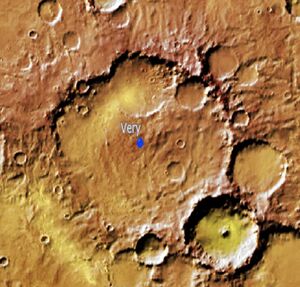Very (Martian crater)
Topic: Astronomy
 From HandWiki - Reading time: 5 min
From HandWiki - Reading time: 5 min
 Topographic location map of Very Crater | |
| Planet | Mars |
|---|---|
| Coordinates | [ ⚑ ] : 49°12′S 177°06′W / 49.2°S 177.1°W |
| Diameter | 114.81 km (71.34 mi) |
Very is a crater on Mars, located south of the planet's equator in the heavily cratered highlands of Terra Sirenum in the Phaethontis quadrangle at 49.2°S and 177.1°W. It measures approximately 114.81 kilometres (71.34 mi) in diameter. The crater was named after American astronomer Frank Washington Very.[1]
Description
On the basis of their form, aspects, positions, and location amongst and apparent interaction with features thought to be rich in water ice, many researchers believed that the processes carving the gullies involve liquid water. However, this remains a topic of active research. As soon as gullies were discovered,[2] researchers began to image many gullies over and over, looking for possible changes. By 2006, some changes were found.[3] Later, with further analysis it was determined that the changes could have occurred by dry granular flows rather than being driven by flowing water.[4][5][6] With continued observations many more changes were found in Gasa Crater and others.[7] With more repeated observations, more and more changes have been found; since the changes occur in the winter and spring, experts are tending to believe that gullies were formed from dry ice. Before-and-after images demonstrated the timing of this activity coincided with seasonal carbon-dioxide frost and temperatures that would not have allowed for liquid water. When dry ice frost changes to a gas, it may lubricate dry material to flow especially on steep slopes.[8][9][10] In some years frost, perhaps as thick as one metre (3 ft 3 in).
See also
References
- ↑ "Gazetteer of Planetary Nomenclature | Very". International Astronomical Union. http://planetarynames.wr.usgs.gov/Feature/6364.
- ↑ Malin, M., Edgett, K. 2000. "Evidence for recent groundwater seepage and surface runoff on Mars". Science 288, 2330–2335.
- ↑ Malin, M., K. Edgett, L. Posiolova, S. McColley, E. Dobrea. 2006. "Present-day impact cratering rate and contemporary gully activity on Mars". Science 314, 1573–1577.
- ↑ Kolb, et al. 2010. "Investigating gully flow emplacement mechanisms using apex slopes". Icarus 2008, 132–142.
- ↑ McEwen, A. et al. 2007. "A closer look at water-related geological activity on Mars". Science 317, 1706–1708.
- ↑ Pelletier, J., et al. 2008. "Recent bright gully deposits on Mars wet or dry flow?" Geology 36, 211–214.
- ↑ NASA/Jet Propulsion Laboratory. "NASA orbiter finds new gully channel on Mars". ScienceDaily. 22 March 2014.
- ↑ "NASA Spacecraft Observes Further Evidence of Dry Ice Gullies on Mars" (in en). https://www.jpl.nasa.gov/news/nasa-spacecraft-observes-further-evidence-of-dry-ice-gullies-on-mars/.
- ↑ "HiRISE | Activity in Martian Gullies (ESP_032078_1420)". https://hirise.lpl.arizona.edu/ESP_032078_1420.
- ↑ July 2014, Nola Taylor Redd 16. "Gullies on Mars Carved by Dry Ice, Not Water" (in en). https://www.space.com/26534-mars-gullies-dry-ice.html.
External links
- NASA Astronomy Picture of the Day: Newton Crater: Evidence for Recent Water on Mars (26 June 2000)
- Newton Crater
- Solar Views
 |
 KSF
KSF

